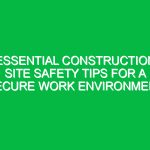# Combatting Fatigue: Essential Tips for Staying Safe and Alert on the Job
Hello team,
Welcome to today’s Toolbox Talk where we will discuss a crucial topic that impacts our health, safety, and overall well-being on the job – combatting fatigue. Fatigue on the job is a significant issue that can lead to accidents, errors, and decreased productivity. By understanding the causes of fatigue and implementing strategies to combat it, we can create a safer and more efficient work environment for everyone.
## Understanding Fatigue on the Job
Fatigue on the job refers to a state of physical or mental exhaustion that can result from various factors such as long work hours, inadequate rest, demanding tasks, stress, or poor health habits. It is important to recognize the signs of fatigue, which can include yawning, difficulty concentrating, irritability, and decreased performance. Fatigue not only affects the individual experiencing it but also poses a risk to the entire team by increasing the likelihood of accidents and errors.
## The Impact of Fatigue on Health, Safety, and Environment (HSE)
Fatigue can have serious consequences in the workplace, particularly in high-risk industries where alertness and quick decision-making are essential for safety. In the HSE domain, fatigue can lead to increased risks of accidents, injuries, and environmental hazards. It is crucial to address fatigue proactively to ensure the well-being of our team members and the integrity of our operations.
## Identifying and Managing Fatigue Risks
To combat fatigue effectively, it is essential to identify and address the underlying causes. Some common risk factors for fatigue on the job include:
– **Long work hours:** Working extended shifts without adequate breaks can lead to fatigue.
– **Poor sleep quality:** Insufficient or disrupted sleep can impair cognitive function and increase fatigue.
– **Stress:** High levels of stress can contribute to mental exhaustion and fatigue.
– **Physical exertion:** Engaging in physically demanding tasks without proper rest can lead to fatigue.
– **Unhealthy lifestyle habits:** Poor nutrition, lack of exercise, and dehydration can also contribute to fatigue.
By recognizing these risk factors and implementing strategies to mitigate them, we can reduce the impact of fatigue on our team members and create a safer work environment.
## Strategies for Combatting Fatigue
To combat fatigue effectively, consider the following tips and best practices:
1. **Prioritize sleep:** Ensure team members get an adequate amount of quality sleep each night to promote alertness and overall well-being.
2. **Take regular breaks:** Encourage team members to take short breaks throughout the day to rest and recharge.
3. **Stay hydrated:** Drink plenty of water to stay hydrated and maintain cognitive function.
4. **Eat well:** Fuel your body with nutritious foods to sustain energy levels throughout the day.
5. **Manage stress:** Encourage stress-reducing activities such as mindfulness, exercise, or relaxation techniques.
6. **Rotate tasks:** Avoid prolonged exposure to repetitive or demanding tasks by rotating responsibilities among team members.
7. **Communicate openly:** Encourage team members to communicate any concerns or issues related to fatigue to promote a supportive work environment.
By implementing these strategies and fostering a culture of safety and well-being, we can combat fatigue effectively and promote a safer workplace for everyone.
## Regulations and Standards
It is important to note that regulatory bodies such as OSHA (Occupational Safety and Health Administration) have guidelines in place to address fatigue in the workplace. Compliance with these regulations is essential to ensure the health and safety of our team members and to meet legal obligations. By following these guidelines and standards, we can create a safer and more compliant work environment.
## Conclusion
In conclusion, combatting fatigue on the job is crucial for maintaining a safe and productive work environment. By understanding the causes of fatigue, implementing strategies to manage it, and promoting a culture of safety and well-being, we can reduce the risks associated with fatigue and ensure the health and safety of our team members. Remember, fatigue is not just a personal issue – it affects us all. Let’s work together to combat fatigue and create a safer workplace for everyone.
Thank you for your attention and commitment to safety. Stay safe, stay alert, and have a productive day!
**Keywords:** toolbox talk, Fatigue on the Job, health, safety, environment, HSE
Remember, your safety is our priority!


